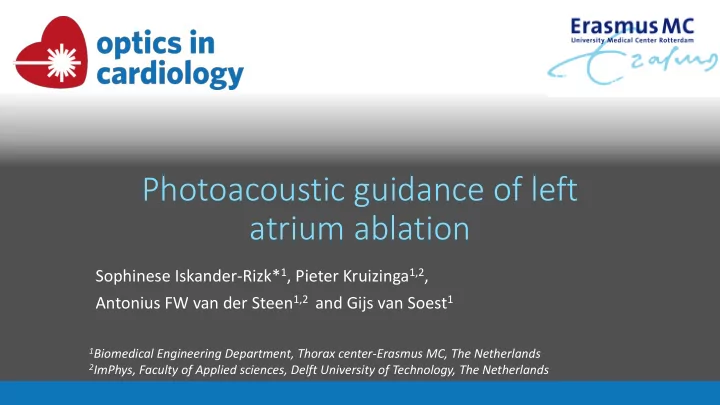

Photoacoustic guidance of left atrium ablation Sophinese Iskander-Rizk* 1 , Pieter Kruizinga 1,2 , Antonius FW van der Steen 1,2 and Gijs van Soest 1 1 Biomedical Engineering Department, Thorax center-Erasmus MC, The Netherlands 2 ImPhys, Faculty of Applied sciences, Delft University of Technology, The Netherlands
RF ablation: a treatment for atrial fibrillation Atrial Fibrillation: • Most common sustained tachyarrhythmia. • Affects 1% of the population • ~30% incidence among ischemic heart patients (4500 new patients/y in NL) Treatment • Catheter based RF ablation of ectopic foci/ conductive substrate L. M. Haegeli, H. Calkins, Catheter ablation of atrial fibrillation: an update , European heart journal, June 2014
Technology for catheter based ablation • • • Electro-anatomical mapping • Visualization and guidance • • • Fluoroscopy − Accurate navigation √ √ ~ − Mapping of ectopic foci • Intracardiac echography (ICE) • Catheter sensors & tracking systems Ablation feedback and evaluation • Late Gadolinium enhancement (LGE) MRI ~ X - Lesion assessment ~ - Conductivity assessment ~ X - Complication prevention Several approaches… yet Over ablation • Indirect lesion assessment Thrombus formation • microbbubles √ Repeat interventions: 30-40% Under ablation M`. Njeim et al., Multimodality Imaging for Guiding EP Ablation Procedures J. Kautzner, P. Peichl, The role of imaging to support X Gaps, transmurality catheter ablation of atrial fibrillation, Cor et Vasa 2012 JACC: Cardiovascular Imaging Jul 2016,
How can optics provide a solution? RF catheter with optical fiber ICE Photoacoustic imaging
Photoacoustic imaging Laser source λ ? Ultrasound Transducer array
Optimal wavelength for lesion imaging Transmission mode PA spectroscopy • Fresh porcine left atrial wall sound out • Sweep 410nm-1000nm in 2 nm steps • L12-3v 192 ch. linear array; 7.8 MHz • Verasonics Vantage 256 1- PA spectroscopy on fresh tissue light in 2- PA spectroscopy on ablated tissue Tissue samples = 14, 23 lesions
Spectroscopic lesion characteristics Pre-ablation Post-ablation 1: lesion site 3: control site
Spectroscopic features can be used for imaging Ratio of images at 𝜇 1 = 790 nm and 𝜇 2 = 930 nm Pre-ablation Post ablation 2 mm 2 mm
Lesion detection: single vs. dual wavelength Criteria on dual wavelength images 𝑻 𝟐 𝒒𝒑𝒕𝒖,𝜇1 • > threshold → post = TP 𝑻 𝟐 𝒒𝒑𝒕𝒖,𝜇2 𝑻 𝟐 𝒒𝒔𝒇,𝜇1 • > threshold → pre = FP 𝑻 𝟐 𝒒𝒔𝒇,𝜇 2 Criteria on single wavelength images 𝑻 𝟐 𝒒𝒑𝒕𝒖 • 𝑻 𝟐 𝑞𝑠𝑓 > threshold → lesion = TP 𝑻 𝟑 𝒒𝒑𝒕𝒖 • 𝑻 𝟑 𝑞𝑠𝑓 > threshold → control = FP 1: lesion site 2,3: control sites
Conclusion • Photoacoustic imaging identifies RF ablation lesions reliably. • Photoacoustic imaging is a promising technology for catheter based ablation for atrial fibrillation Funding Acknowledgment Frits Mastik ,Robert Beurskens Geert Springeling, Klazina Kooiman Hans Bosch, Jason Voorneveld, Jovana Janjic, Ayla Hoogendoorn, Min Wu Hendrik Vos, Maaike te Lintel Hekkert, Mirjam Visscher and Alex Brouwer.
Recommend
More recommend